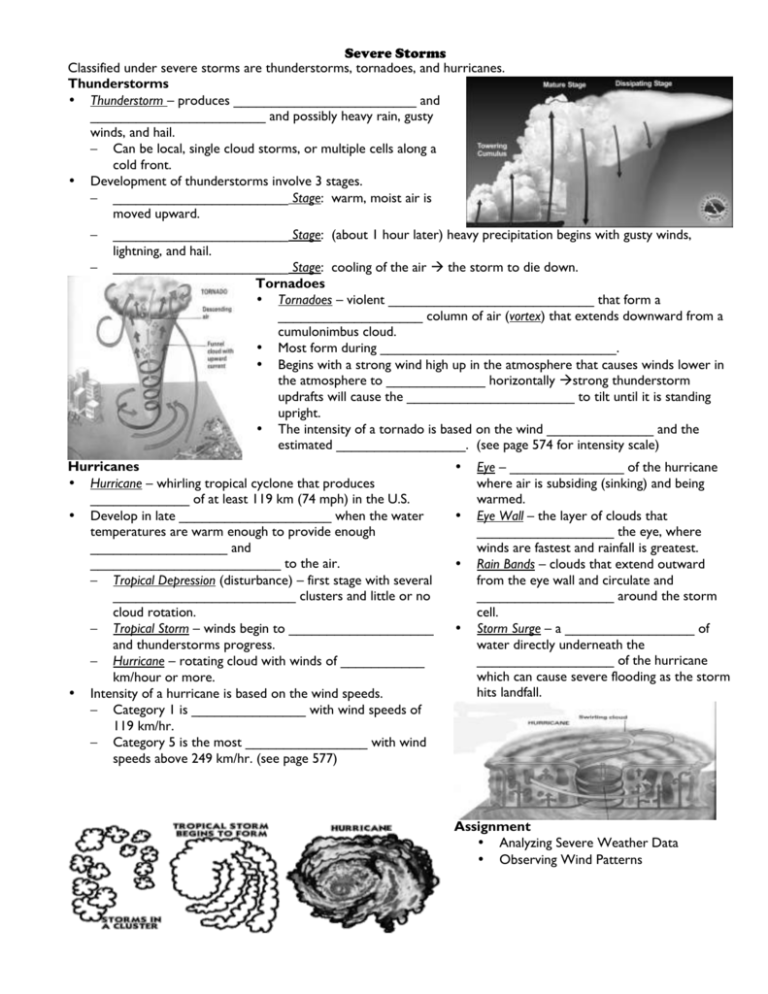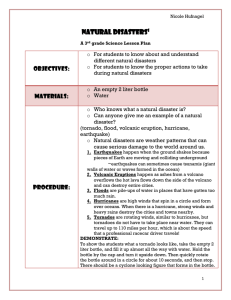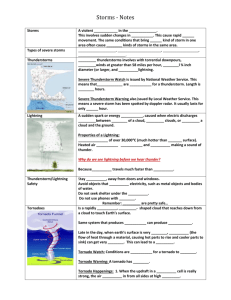Severe Storms - Mr. Carter`s Earth
advertisement

Severe Storms Classified under severe storms are thunderstorms, tornadoes, and hurricanes. Thunderstorms • Thunderstorm – produces ________________________ and _______________________ and possibly heavy rain, gusty winds, and hail. – Can be local, single cloud storms, or multiple cells along a cold front. • Development of thunderstorms involve 3 stages. – _______________________ Stage: warm, moist air is moved upward. – – _______________________ Stage: (about 1 hour later) heavy precipitation begins with gusty winds, lightning, and hail. _______________________ Stage: cooling of the air the storm to die down. Tornadoes • Tornadoes – violent ___________________________ that form a ___________________ column of air (vortex) that extends downward from a cumulonimbus cloud. • Most form during _______________________________. • Begins with a strong wind high up in the atmosphere that causes winds lower in the atmosphere to _____________ horizontally strong thunderstorm updrafts will cause the ______________________ to tilt until it is standing upright. • The intensity of a tornado is based on the wind ______________ and the estimated _________________. (see page 574 for intensity scale) Hurricanes • Hurricane – whirling tropical cyclone that produces _____________ of at least 119 km (74 mph) in the U.S. • Develop in late ____________________ when the water temperatures are warm enough to provide enough __________________ and _________________________ to the air. – Tropical Depression (disturbance) – first stage with several ________________________ clusters and little or no cloud rotation. – Tropical Storm – winds begin to ___________________ and thunderstorms progress. – Hurricane – rotating cloud with winds of ___________ km/hour or more. • Intensity of a hurricane is based on the wind speeds. – Category 1 is _______________ with wind speeds of 119 km/hr. – Category 5 is the most ________________ with wind speeds above 249 km/hr. (see page 577) • • • • Eye – _______________ of the hurricane where air is subsiding (sinking) and being warmed. Eye Wall – the layer of clouds that __________________ the eye, where winds are fastest and rainfall is greatest. Rain Bands – clouds that extend outward from the eye wall and circulate and __________________ around the storm cell. Storm Surge – a _________________ of water directly underneath the __________________ of the hurricane which can cause severe flooding as the storm hits landfall. Assignment • Analyzing Severe Weather Data • Observing Wind Patterns Severe Storms (Honors) Classified under severe storms are _____________________________________________________________ Thunderstorms • Thunderstorm – ____________________________________ _______________________________________________ – What sizes can thunderstorms be? __________________ ____________________________________________ • Development of thunderstorms involve 3 stages. – 1st Stage: _____________________________________ ____________________________________________ ____________________________________________ – – 2nd Stage: __________________________________________________________________________ _________________________________________________________________________________ 3rd Stage: __________________________________________________________________________ _________________________________________________________________________________ Tornadoes • Tornadoes – __________________________________________________ ___________________________________________________________ • When do they form? ___________________________________________ • What are the stages of development for a tornado? _____________________ ___________________________________________________________ ___________________________________________________________ ___________________________________________________________ • How is the intensity of a tornado determined? _________________________ ___________________________________________________________ ___________________________________________________________ Hurricanes • Hurricane – _____________________________________ _____________________________________________ • When do hurricanes develop? _______________________ _____________________________________________ _____________________________________________ _____________________________________________ – 1st Stage ____________________________________ ___________________________________________ ___________________________________________ – 2nd Stage ____________________________________ ___________________________________________ ___________________________________________ – 3rd Stage ____________________________________ ___________________________________________ ___________________________________________ • How is the intensity of a hurricane measured? ___________ _____________________________________________ _____________________________________________ _____________________________________________ • • • • Eye – _____________________________ _________________________________ _________________________________ Eye Wall – _________________________ _________________________________ _________________________________ Rain Bands – ________________________ _________________________________ _________________________________ Storm Surge – _______________________ _________________________________ _________________________________ _________________________________ Assignment • Analyzing Severe Weather Data • Observing Wind Patterns Classroom Hygrometer Lab Background Humidity is a measure of the amount of water vapor present in the air at any given temperature. The amount of water vapor present in the air is directly related to the temperature. The higher the temperature, the more water vapor can be suspended in the air. However, it also depends on the amount available water to be moved in the air. In warmer climates, the air is able to hold more water vapor which often leads to a more humid environment. Pinecones are natural hydrometers. You can often tell how humid it is by looking at pinecones. When air is dry, pinecones open their scales to disperse seeds. In high humidity or rain, they close them to protect the seeds. In this activity, you will use pinecones to model a hygrometer, a device that measures the moisture content of air. Procedure 1. Write the experimental question and hypothesis. Identify the variables used in the experiment. 2. Obtain 3 – 2 liter bottles with lids per group. 3. Cut off the top third of the each and remove any label still on the bottle. 4. In 2 of the bottles, place ¼ cup of water in the bottom. Leave the 3 rd bottle empty. 5. Tape a thermometer to the inside of each bottle with clear tape. 6. Attach a string to each pinecone and hang 1 pinecone from the opening of each bottle. Screw the bottle cap on to hold the string in place. 7. Tape the bottle back together using the clear packing tape. 8. Label the bottle with your group members’ names/initials. 9. Place 1 of the bottle with water and the bottle without water under the heat lamp. Place the other bottle with water in the cabinet. 10. Complete the initial readings on the table on the next page. 11. Leave them overnight, then check them for changes. 12. Complete the remainder of the table and answer the questions. Name _____________________________________________ Period _______ Date ________________ Question: (What are you trying to determine with this experiment?) ___________________________________________________________________________________ ___________________________________________________________________________________ Hypothesis: (What do you predict will happen?) ___________________________________________________________________________________ ___________________________________________________________________________________ Variables: 1. What is your independent variable? ________________________________ 2. What is your dependent variable? ________________________________ 3. What is your control? ________________________________ Data/Observations: Bottle #1 Initial Observations Temperature Pinecone Bottle #2 Bottle #3 (open or closed) Temperature Final Observations Pinecone (open or closed) Humidity (none, low, high) Post-Lab Questions: 1. Which jar was most humid? ________________________________ 2. Which was least humid? ________________________________ 3. How did the temperature affect the humidity? _____________________________________________________________________________ _____________________________________________________________________________ 4. Did the amount of liquid water in the bottle change overnight? Why or why not? _____________________________________________________________________________ _____________________________________________________________________________ Conclusion: (Did your result match your hypothesis? Why or why not? What did you learn by completing this lab?)








